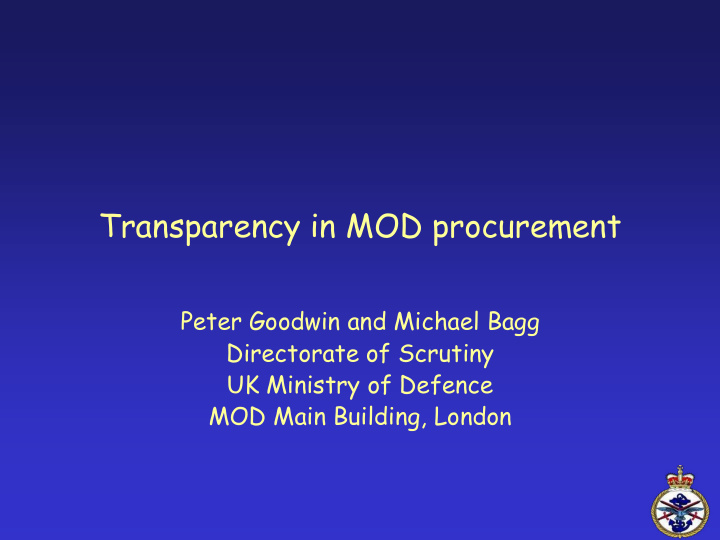



Transparency in MOD procurement Peter Goodwin and Michael Bagg Directorate of Scrutiny UK Ministry of Defence MOD Main Building, London
Affordability • A Hard-headed Approach To What We Can Afford – Banner display in the foyer of Main Building • Affordability is a limit, not a spend target • Defence needs to buy only what it really needs and at the lowest possible price – Achieving Better for Less
Moving from ‘The Old Days’ • The traditional approach perceived to be ‘buy the best’ we can for the money available – JSP 507 informs value-for-money decision – Delays led to a funding ‘black - hole’ of £38Bn • Defence budget recently announced to be ‘under control’ – but must be kept there • The emphasis is now on doing what we really have to do at reduced cost
Procurement regulations • EU Public Procurement Regulations frame the methods applied to contracting • ‘War - like Stores’ exempt from the regulations – but the principles still apply as best practice • Much Defence expenditure is on services and non-exempt equipment • There is an over-riding requirement for ‘transparency’ in all procurement action
The Regulations • EU Directive Public Contracts 2004/18/EC and 2009/81/EC – UK Statutory Instrument 2006 No. 5 – The Public Contract Regulations 2006 – UK Statutory Instrument 2011 No. 1848 - The Defence and Security Public Contracts Regulations 2011 • Designed to ensure fully fair and open competition in Public Procurement
Transparency • Telling everyone exactly how the competition is to be determined at the start of the process and then sticking exactly to it • Traditionally a COEIA has been used at the end of a competition to select the ‘winner’ – This does not achieve transparency • A COEIA can still be used to consider a ‘winning’ bid against non-procurement options
The COEIA plot • The final decision on a procurement is made by comparing the preferred bid with other options – Only the ‘winning’ Preferred Bid can be selected Effectiveness Preferred Bid In-house development Other bid 1 In-house extension Other bid 2 Do nothing Cost
The issue • It is important that the selected bid offers the right capability at the right price • The selection criteria must focus on capability delivery while ensuring value for money
Selection methods • If we know what we want we could take the lowest cost compliant bid • If we want the best capability we could take the technically best affordable bid • Balancing cost and capability can define a basis for a Most Economically Advantageous Tender (MEAT) • Value For Money must always be demonstrated • Recent projects have used a number of approaches
Potential COEIA problems • Defining the selection criteria is not easy • Lowest cost – a bit dearer and much better fails • Best – not quite as good but much cheaper fails B O Y P Effectiveness X O A P Best Lowest cost Cost
Example - Equipment • Technical specification defined required capability – Bids evaluated to establish acceptability • Winning bid decision made on basis of lowest cost • In the event of cost overlap the decision made on greatest capability score – maximising capability for a given cost • Approach generated savings for Defence against allocated budget, excess returned
Example – continuing service • Renewal of an existing outsourced service • No requirement to improve the current service levels, just sustain the delivery • Selection aimed to achieve the lowest cost solution • A strong competition ensured that quality was maintained without cost inflation – Funding returned from the budget allocation
Example – ‘best’ service • Unusual example – a fixed budget, but reduced from current levels – Therefore need to obtain the best possible capability for the reduced money – Bidders informed of money limit – Necessarily providing a reduced service • Selection focussed upon technical excellence
Example – new outsourcing • New contract to outsource a service from in-house provision • Aim to modernise delivery at an affordable price – Improvement in outcomes required • MOD prepared to pay a premium for improved performance – Contractor incentivised with metrics based upon long-term outputs • Funding returned from the budget allocation
What is the cost? • Prices from industry are not the Project cost – Authority expenditure – Authority risk provision and management • VFM has to consider Whole Life Cost – So when are costs different? – What are we prepared to pay?
Cost overlap • Must consider Risked Whole Life Costs – Costs might be considered ‘different’ if profiles do not overlap – A project has looked for separation in the inter- quartile range of the risk analysis • Lowest overlapping bids separated technically Bid 3 10% 25% 50% 75% 90% Bid 2 Bid 1 Cost
‘Scientific’ selection methods • Seeking a more scientific basis for cost comparison VFM – Supported by Dstl and University of Strathclyde • Statistical tests are difficult to implement as datasets are skewed and often with different profiles
Work in progress • Guidance being provided to Project teams on defining ‘Quality’ criteria – JSP507 being updated • Investigating methods to test cost ‘differences’ – Supported by Dstl • Investigation methods to compare bids that are not firm price – Could be Not To Exceed prices or Rate Cards
So What? • Defining selection criteria is ‘easy’ – Defining the right criteria to deliver the best capability at least cost requires significant effort • Comparing prices is much more complex than just taking the bid prices – When are prices effectively ‘the same’? • Setting the relationship between ‘quality’ and ‘cost’ has to be a decision for each project • Above all, everything must be transparent
Recommend
More recommend